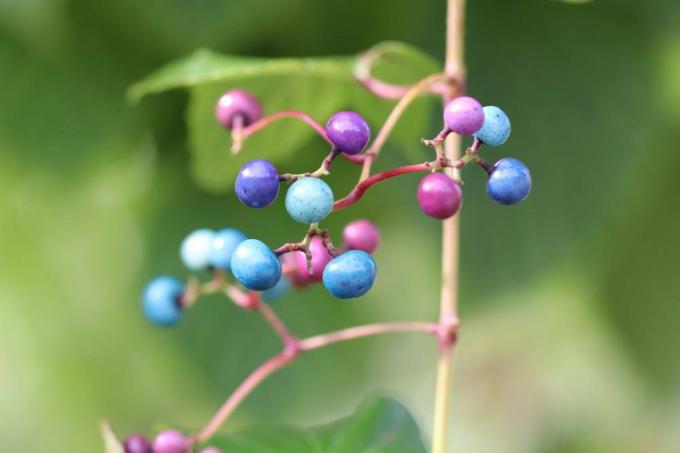
table of contents
- Characteristics
- Location
- Plant substrate
- to water
- Fertilize
- cut
- Repot
- Diseases and pests
Profile and care information open +conclude -
- Flower color
- inconspicuous, green
- Location
- Partial shade, shady, sunny
- Heyday
- June July August
- Growth habit
- spreading, perennial, climber
- height
- up to 8 m long
- Soil moisture
- moderately moist
- PH value
- neutral, weakly alkaline, weakly acidic, alkaline, acidic
- Limescale tolerance
- Calcium tolerant
- humus
- rich in humus
- Poisonous
- Yes
- Plant families
- Grapevines, Vitaceae
- Plant species
- Container plants, house plants, ornamental plants
- Garden style
- Natural garden, wild garden, country house garden, ornamental garden
The Ussuri false vine or Ampelopsis brevipedunculata is the ideal choice for everyone who wants to bring climbing plants into the house or garden. It is considered to be undemanding and easy to care for. Since it is also forgiving of care mistakes, the false vine is perfect for beginners. In addition, the plant grows extremely lush and bears visually attractive fruits. And because it is generally frost-hardy, it may even be possible to overwinter outdoors.
Characteristics
- botanical name: Ampelopsis brevipedunculata
- Genus: Ampelopsis (false vines)
- belongs to the grapevine family (Vitaceae)
- Trivial names: Ussuri-Scheinrebe, Scheinrebe, Jungfernrebe, Zimmerwein
- perennial climbing shrub, the tendrils of which, however, do not form adhesive discs
- Height: up to eight meters (with climbing aid)
- Leaves: three- or five-lobed, finger-shaped, dark green, hairy on the underside
- Flowers: small, green colored, lying on cymene
- Flowering period: June to August
- Fruits: round or spherical, initially pink to purple in color, ripe clear blue
- Toxicity: all parts of the plant contain substances that can irritate the skin, fruits are not edible
- Origin: Asia, Central and North America
- hardy
- easy-care
- lime tolerant
Location
Ampelopsis brevipedunculata prefers a light to partially shady site. However, it is essential to avoid direct sunlight. They can be grown indoors, on the balcony, and even outdoors. In winter you should make sure that the room temperature does not exceed 15 degrees Celsius. In other words: the plant likes it cool rather than warm during this time. Basically, sub-zero temperatures between five and 15 degrees cannot harm it. With some protection such as a plant fleece, it is therefore also possible to overwinter in the garden.
Plant substrate
No special substrate is required to cultivate Ampelopsis brevipedunculata. Conventional potting soil is sufficient. However, hydroponics are also suitable.

to water
Like other grapevine plants, Ampelopsis brevipedunculata also needs a relatively large amount of water. It has to be watered regularly from spring to autumn. It is important that the plant substrate is kept moist at all times and that the surface never dries out. It is best to pour until the water runs out of the drain hole on the floor and collects in the saucer. The coaster is then emptied after around 20 minutes. Waterlogging must be avoided in the same way as dry balls. In winter you give less water, but make sure that the soil remains moist throughout. If the humidity is low, the leaves of the false vine should be sprayed. Rainwater is ideal for this.
Fertilize
During the summer growth phase, fertilization should be carried out every 14 days. Basically, all types of fertilizer that are suitable for green or green areas are suitable for this. Climbing plants are designed. In winter, however, the application of fertilizer must be completely stopped.
cut
In the resting phase, the Ussuri pseudo-vine loses a relatively large number of leaves. It is therefore important to cut back the shoots vigorously shortly before the shoots begin in spring. Shoots that are too long can be cut off by two-thirds of their length.
Repot
If the previous planter has become too small, it is best to repot Ampelopsis brevipedunculata in early spring. The old soil is largely shaken out of the roots. The complete removal of dead root parts has proven itself.
Diseases and pests
In waterlogging, a dry root ball or a change of location, the Ussuri pseudo-vine tends to lose leaves. Too dry or too warm locations in winter can quickly lead to an infestation with spider mites or aphids.


